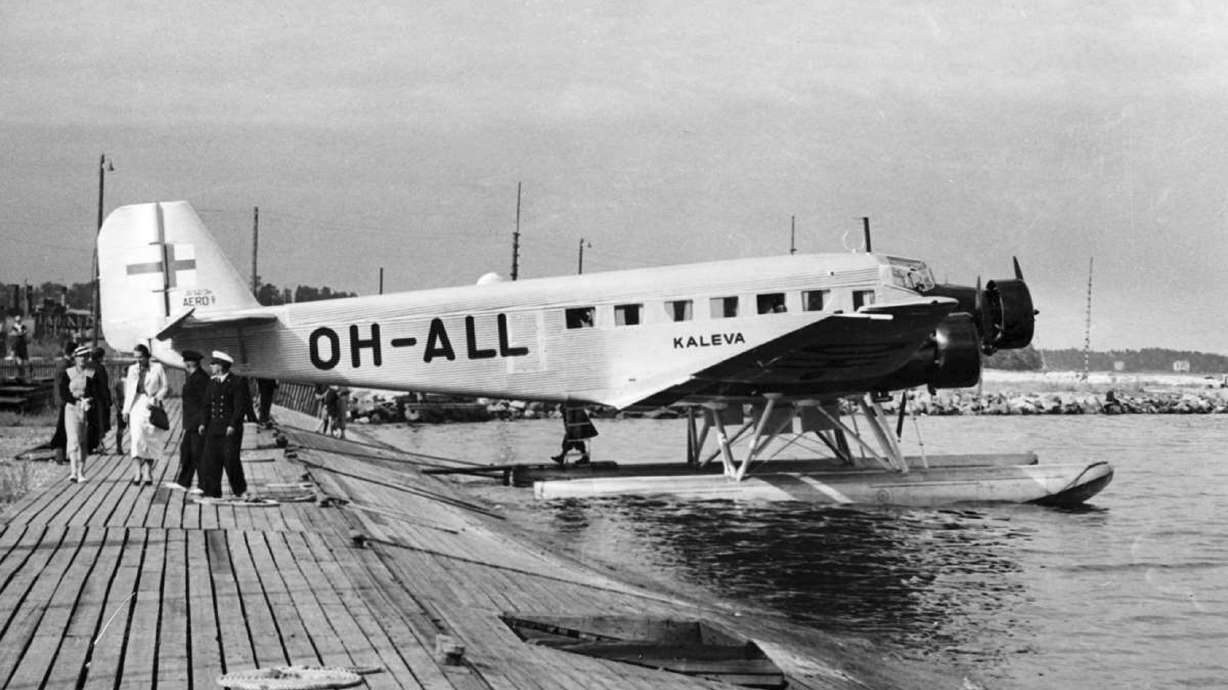Estimated read time: 4-5 minutes
This archived news story is available only for your personal, non-commercial use. Information in the story may be outdated or superseded by additional information. Reading or replaying the story in its archived form does not constitute a republication of the story.
HELSINKI — The World War II mystery of what happened to a Finnish passenger plane after it was shot down over the Baltic Sea by Soviet bombers appears to finally be solved more than eight decades later.
The plane was carrying American and French diplomatic couriers in June 1940 when it was downed just days before Moscow annexed the Baltic states. All nine people on board the plane were killed, including the two-member Finnish crew and the seven passengers — an American diplomat, two French, two Germans, a Swede and a dual Estonian-Finnish national.
A diving and salvage team in Estonia said that it had located well-preserved parts and debris from the Junkers Ju 52 plane operated by Finnish airline Aero, which is now Finnair. It was found off the tiny island of Keri near Estonia's capital, Tallinn, at a depth of around 230 feet.
"Basically, we started from scratch. We took a whole different approach to the search," Kaido Peremees, spokesman for underwater survey company Tuukritoode OU, explained the group's success in finding the plane's remains.
The downing of the civilian plane, named Kaleva, en route from Tallinn to Helsinki happened on June 14, 1940 — just three months after Finland had signed a peace treaty with Moscow following the 1939-40 Winter War.
The news about the fate of the plane was met with disbelief and anger by authorities in Helsinki who were informed that it was shot down by two Soviet DB-3 bombers 10 minutes after taking off from Tallinn's Ulemiste airport.
"It was unique that a passenger plane was shot down during peacetime on a normal scheduled flight," said Finnish aviation historian Carl-Fredrik Geust.
Finland officially kept silent for years about the details of the aircraft's destruction because it didn't want to provoke Moscow.

The case is an essential part of the Nordic country's complex World War II history and sheds light into its troubled ties with Moscow.
The downing of the plane happened at a critical time just days before Josef Stalin's Soviet Union was preparing to annex the three Baltic states, sealing the fate of Estonia, Latvia and Lithuania for the next half-century before they eventually regained independence in 1991.
Moscow occupied Estonia on June 17, 1940 and Kaleva's doomed journey was the last flight out of Tallinn, though Soviets had already started enforcing a tight transport embargo around the Estonian capital.
American diplomat Henry W. Antheil Jr., who is now considered one of the first U.S. casualties of World War II, was aboard the plane when it went down.
The 27-year-old Antheil was on a rushed government mission evacuating sensitive diplomatic pouches from U.S. missions in Tallinn and Riga, Latvia, as it had become clear that Moscow was preparing to swallow up the small Baltic nations.
Lots of speculation
An Associated Press wire item dated June 15, 1940 noted that "Henry W. Antheil Jr. of Trenton, N. J., attached to the United States Legation in Helsinki, was killed in the mysterious explosion of a Finnish airliner yesterday." In the U.S. media, Antheil's death was overshadowed by much bigger news from Europe at the time: the Nazi occupation of Paris.
Earlier this month, the U.S. ambassador in Estonia, George P. Kent, shared a post on X that included photos of Antheil, Kaleva and a memorial plaque by the American Foreign Service Association in Washington with Antheil's name engraved in it.
Kaleva was carrying 500 pounds of diplomatic post, including Antheil's pouches and material from two French diplomatic couriers — identified as Paul Longuet and Frederic Marty.
Estonian fishermen and the lighthouse operator on Keri told Finnish media decades after the downing of the plane that a Soviet submarine surfaced close to Kaleva's crash site and retrieved floating debris, including document pouches, that had been collected by fishermen from the site.
This has led to conspiracy theories regarding the contents of the pouches and Moscow's decision to shoot down the plane. It still remains unclear why precisely the Soviet Union decided to down a civilian Finnish passenger plane during peacetime.

"Lots of speculation on the plane's cargo has been heard over the years," Geust said. "What was the plane transporting? Many suggest Moscow wanted to prevent sensitive material and documents from exiting Estonia."
But he said that it could have simply been "a mistake" by the Soviet bomber pilots.
Not even the U.S. Navy's oceanographic survey vessel Pathfinder could locate remains of the plane in a 2008 search.
"The wreckage is in pieces and the seabed is quite challenging with rock formations, valleys and hills. It's very easy to miss" small parts and debris from the aircraft, Peremees said. "Techniques have, of course, evolved a lot over the time. As always, you can have good technology but be out of luck."
Jaakko Schildt, chief operations officer of Finnair, described Kaleva's downing as "a tragic and profoundly sad event for the young airline" that Finnair, then named Aero, was in 1940.
"Finding the wreckage of Kaleva in a way brings closure to this, even though it does not bring back the lives of our customers and crew that were lost," Schildt said. "The interest towards locating Kaleva in the Baltic Sea speaks of the importance this tragic event has in the aviation history of our region."








